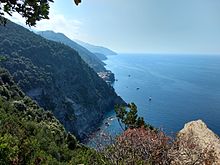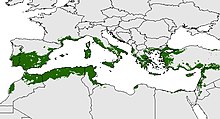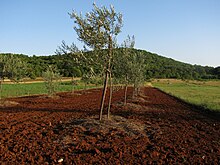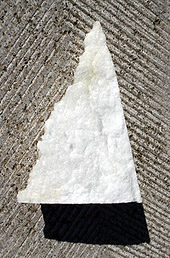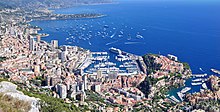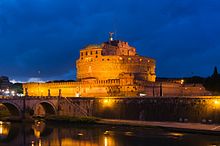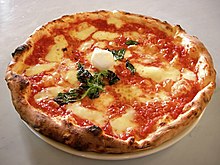Mediterranean area
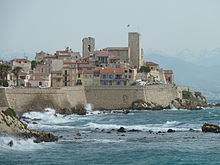
The Mediterranean , also known as the Mediterraneum , is the greater region around the Mediterranean .
The Mediterranean area is an intercontinental region that includes the Mediterranean Sea with its islands and the coastal mainland regions of three continents, which are included in Southern Europe , Western Asia and North Africa . The term Mediterranean can be defined more precisely according to physical-geographical , political , climatological , biogeographical and cultural aspects.
Geography and geology
Delimitation and expansion

In total, this area extends over more than 1.3 million km² of land mass and 2.5 million km² that covers the Mediterranean Sea. The northernmost point is the foot of the Alps in Veneto , the westernmost point is Cabo da Roca near Lisbon . In the east and south, the transitions to the Syrian Desert and the Sahara respectively mark the borders, whereby the demarcation in the south is arbitrary, because there the desert climate (e.g. at Port Said in the north of Sinai ) extends right up to the coast.
The Mediterranean area is divided over the three continents Europe , Africa and Asia . In Europe it extends in whole or in part - from west to east - over Portugal , Spain , Andorra , France , Monaco , Italy , San Marino , Vatican City , Malta , Slovenia , Croatia , Bosnia-Herzegovina , Montenegro , Albania , Greece and the European Turkey . The Asian part includes Turkey, Asia Minor, as well as Syria , Lebanon , Israel , the Palestinian Autonomous Areas and Jordan and the island of Cyprus . In Africa - east to west - the northern parts of Egypt , Libya , Tunisia , Algeria and Morocco belong to the Mediterranean area.
The Mediterranean region is generally defined by the mountain ranges surrounding the Mediterranean: Pyrenees , Alps , Dinarides , Serbo-Macedonian massif , Rhodope , Taurus , Lebanon , West Bank mountains , Sinai , Libyan desert plate , Hammada al-Hamra (Tripolitan rocky desert) and Atlas . This largely corresponds to the catchment area of the Mediterranean Sea (in the lower reaches), apart from the Nile region and some rivers such as the Rhone .
In the narrower sense, it is delimited by the natural and potential distribution area of the olive tree , which is why it is also referred to as the olive tree boundary . This definition equates the Mediterranean area with the distribution of the Mediterranean climate in Europe, the Middle East and Northern Africa. Some coastal regions of the Mediterranean are already in neighboring biogeographical climatic regions. On the other hand, some areas with a Mediterranean climate that are too far from the Mediterranean do not belong to the Greater Region (for example areas around the Black Sea and the high elevations of the Zagros Mountains in Iran).
The states whose territories participate in this area are called Mediterranean countries . Most of the Mediterranean countries in the real sense, z. B. France, Turkey or the countries of North Africa, only a small part of the Mediterranean area. Portugal and Jordan are included in the Mediterranean world for cultural and climatic reasons, although they have no coast to the Mediterranean at all.
relief

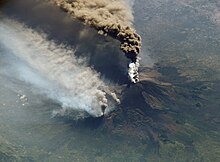
The location within a tectonically active zone favors an overall strong relief with high relief energy , which is mostly formed by high fold mountains , but to a lesser extent also by volcanoes . Due to their height, the mountain ranges are often the climatic divide between the Mediterranean climate and the temperate or desert climate . In Europe, the Mediterranean area is demarcated to the north by an almost continuous bar, which runs from the Cantabrian Mountains over the Pyrenees , the Massif Central and the Alps to their southeastern continuation. The Dinaric Mountains in Croatia and Montenegro even move right up to the coast, so that the Mediterranean area is compressed here to a width of a few kilometers. This bar ends in the Rhodope Mountains . Within the Mediterranean are the Iberian peripheral and central mountains ( Sierra Nevada , Coastal Cordillera and Castilian Scheidegebirge ), the Apennines in Italy and the Greek mountain ranges. There are also massifs on all of the larger islands, some of which represent the continuation of continental mountains.
The relief of Turkey is similar to that of Spain: high mountain ranges enclose a central plateau . In contrast to the Castilian highlands, however, due to the harsher climate, the Anatolian highlands are no longer part of the Mediterranean, so that the Taurus Mountains , which run through all of southern Turkey, are also considered a climatic divide. On the Levant coast, the Lebanon mountains seal off the Mediterranean area from the desert on the leeward side . In Africa, the atlas also creates a clear border with the desert. Only the Libyan and Egyptian coasts do not have any pronounced relief.
Since the main ridges of the northern border mountains are definitely not part of the Mediterranean, the Toubkal (4165 m) in the High Atlas is its highest elevation. In Europe, the Mulhacén (3482 m) in the Sierra Nevada is the highest peak. The highest mountain of the islands and at the same time the highest volcano in Europe is Mount Etna at around 3,323 meters, although the peak height fluctuates over the years due to the lively activity.
The orographic conditions leave little space for plains : According to the FAO terrain classification , only 29% of the area is flat to undulating compared to 53% undulating to mountainous land (dominant slope over 8%) and 18% mountainous land with a slope over 30%. . Plains are found mainly in geologically ancient regions (Spanish Meseta and North Africa without Atlas) and in the few sedimentary basins.
climate
The Mediterranean area is almost exclusively determined by the Mediterranean climate named after it , which is also found in other parts of the world. The Mediterranean region alone has between 50 and 60% of these climates.
The Mediterranean climate type is also called the winter rainy climate of the west sides . This climate is here thus concluded, is that the region on the border between the Kalmenzone the subtropics (horse latitudes) and the westerlies of temperate latitudes is, and to the north - with few inroads - to polar cold air is shielded, to the south of Sahara towards but largely open. In the summer, the Azores high determines the events by spreading practically over the entire Mediterranean area. The result is low-wind, sunshine-rich weather - to put it simply, the desert climate moves north in summer. In winter, the opposite effect occurs: the high usually shifts to the south and leaves the Mediterranean area in the area of influence of the westerly winds saturated over the Atlantic. The Mediterranean area rarely comes under the influence of polar cold spells or continental winter highs, which can then bring snow to the southern coasts.
The Mediterranean area has an autochthonous (only occurring here) center of action , the typical trajectory of a cyclone , the Mediterranean Depression : These depressions can be pushed south from the Atlantic-West European area by north European highs or polar north winds and therefore north or south of the Pyrenees into the Mediterranean area drag, or form in the western Mediterranean. There they can replenish themselves with water again and again, so that they bring abundant rain in a row. Sometimes they dissolve again over Italy and the Adriatic Sea, sometimes they move over the Balkans towards the Black Sea or in the eastern Mediterranean to the Middle East , and rarely towards Central Eastern Europe ( Vb weather conditions ). There are Mediterranean lows in all seasons, but more often in spring and autumn.
Typical winds in the Mediterranean, controlled by the Mediterranean lows or the surrounding action centers, are:
- the foehn , a warm, stormy balancing wind that blows mostly northwards on the north side of the Alps (rain on the south side of the Alps), but less often the other way around over the south side of the Alps into the Italian Mediterranean region (south foehn)
- the Mistral , a dry fall wind in the Rhone Valley from the north
- the foehn-like high-altitude current , at the front of the Atlantic-West European lows from southeast to central Europe, controlled warm, dry air masses. It leads to extensive thermal bursts or heat waves and also transports the well-known Saharan dust
- the bora , a very cold, often stormy northeast wind on the upper Adriatic
- the Scirocco , a warm wind blowing from the southwest to the south, which pulls from the Sahara over the Mediterranean, where it is charged with moisture
- the Meltemi (also called Etesia ), a summer north wind occurring in the Aegean (after this also older Etesia climate for the Mediterranean climate in the narrower sense)
- the Chamsin , a dry, hot desert wind on the Levant coast
The Mediterranean climate is characterized by mild, rainy winters and hot, dry summers. The distribution area of the olive tree coincides with the 5 ° -Januarisotherme together, the corresponding air is also called olive tree air designated: This limit is called olive tree limit . The higher altitudes are generally cooler (hottest month below 22 ° C) - this is referred to as the Erikenklima . Differences in climatic characteristics do not only exist between low and high altitudes, but also between the northern and southern, western and eastern Mediterranean regions. The greatest advance of the Mediterranean climate to the north is observed in the Rhone Valley, where the typical climatic characteristics are observed up to about 45 ° north latitude.
In the western Mediterranean region, precipitation tends to be higher. This applies in particular to the west sides of the land masses, where winter cyclones can rain down. So the amounts of precipitation exceed z. B. on the Ligurian coast ( Genoa ) and in northern Portugal the 1000 mm mark, Rome , Algiers and Gibraltar also receive copious amounts of winter rain. The eastern Mediterranean, on the other hand, is markedly more continental - only the western sides of the mountains ( Levant Coast , Montenegro , western Greece ) still reach precipitation levels of over 500 mm per year, while the eastern sides can quickly become very dry.
In addition, the northern regions are generally cooler and more humid than the southern regions. The length of the summer drought also increases from north to south and from west to east. For example, if Avignon is only arid about 45 days a year , this value increases to almost 200 days in Jerusalem .
Characteristic for the Mediterranean climate are strong variabilities in precipitation and temperature. In the continental eastern part in particular, late onset of winter with snowfall can occur in March, on the other hand, heat waves of well over 40 ° C and long droughts are not uncommon. The winter rains can take on torrential proportions and sometimes reach several times a whole month's average in a single day. Floods and increased erosion are the consequences. The success of several wet or dry years can be catastrophic for agriculture.
In the southern part of the Mediterranean, the transition to steppes - and even desert climates - is already taking place . The steppe climate begins below 300 mm of annual precipitation and affects large parts of the Libyan and Egyptian coasts, but also some small-scale regions in Spain: In the lee of the central Spanish highlands (the Meseta ) and the adjacent mountains, for example , the Cabo de Gata near Almería only receives roughly 200 mm. Gaza has to get by with 130 mm. In the extreme south, the desert reaches as far as the coast.
The area around the Upper Adriatic is already counted in the temperate zone. In the Po Valley , in Veneto and on the Slovenian coast , there is no longer a closed dry period, although the temperatures are mild there too.
Waters
Almost all rivers in the Mediterranean flow into the Mediterranean. As far as these arise in the same region, they are mostly short and have a steep gradient. Longer rivers form when the headwaters are located in humid climatic regions ( Nile , Rhone , Po ) or a larger area is drained ( Ebro , in the direction of the Atlantic also Tajo , Duero , Guadalquivir ). The higher the water flow, the stronger the sediment transport, so that wide alluvial plains can arise. Rivers that flow into the Mediterranean then tend to form delta and new land in the mouth area. These regions are also the most fertile in the whole of the Mediterranean.
Lakes mostly only exist on a small scale in the Mediterranean. Along the French Mediterranean coast in Languedoc there are a series of fresh, brackish and salt water reservoirs, the étangs , which were formed by the special wind conditions: drifting sand is driven through the mistral parallel to the coast, which means that former bays have been cut off from the open sea. The salinity of the corresponding lake varies depending on the subsequent freshwater input . The largest of these lakes is the Étang de Vaccarès in the Rhône delta. Other lakes are formed in hilly or mountainous terrain, but are mostly small. A well-known representative is Lake Trasimeno in Umbria . As far as there are no drainage areas in the Mediterranean, salt lakes (bulkheads) can also form, which sometimes dry out completely in summer. This is especially the case on the high altitudes of the Atlas.
A special feature of the Iberian Peninsula is the large number of artificial reservoirs that line up almost continuously along the large rivers. The deep river valleys in otherwise relatively flat areas facilitate the construction of dams, which can hold back enough water for water management regardless of the season due to the abundant winter water supply . In the rest of the Mediterranean, there is hardly any terrain suitable for economically operated reservoirs.
geology
The Mediterranean is a tectonically very active region that lies above the intersection of several continental plates. The southern half is part of the African plate, which moves north and slowly pushes under the Eurasian plate in the north. Between them is the smaller Anatolian Plate , along which the strongest wedges occur, so that in the eastern Mediterranean there are often even stronger earthquakes than in the west. The colliding plates have resulted in almost the entire Mediterranean basin falling into the Alpine Folding zone . Mighty mountains define most of the coast and its hinterland.
In addition to folding, there were also fracture and migration tendencies in the Tertiary: Iberia and the Apulian plate with Italy and Sicily broke away from Africa and drifted separately towards Eurasia , before the African continent followed. In addition, Corsica and Sardinia broke away from the European peninsula and moved in a 90 degree curve towards Italy.
The oldest rock formations are found in northeast Africa, which is part of the African shield. The Iberian Peninsula also largely consists of ancient or metamorphic rocks : here, for example, you can find mighty granite massifs . Most of the rest of the Mediterranean is made up of Tertiary mountain formations , when the collision of the plates pushed the old sea floor up thousands of meters. The formative limestone mountains have risen here, which often form a very steep relief due to rapid weathering. These are supplemented by effluent rocks ( basalt ) due to high volcanic activity along the plate boundaries. From a geological point of view, the Mediterranean region can therefore be described as young. Except for some sediment deposits on the river plains, the most recent geological features are missing, especially those of the Pleistocene Ice Ages , which, for example, shaped the appearance of Northern and Central Europe.
Floors
In a world soil map of the FAO and UNESCO , the soil zone Chromic Luvisol / Calcaric Cambisol is generally given for the northern Mediterranean and northwest Africa . So there are bright red Luvisol soils and brown earths with calcareous rock. However, there is no uniform distribution of one soil type in the Mediterranean region . Due to the small chambers of horizontal and vertical relief, there is a spotty distribution of a large number of soils.
There is, for example, terra rossa and brown earth as well as semi-desert or dark clay soils. In addition, none of the soil types that occur is classified as exclusively Mediterranean, because all soils also occur in neighboring regions. Generally they are red to brownish in color. The terra rossa soils, which are best described as Mediterranean, are particularly characteristic of this region. This soil is very suitable for agriculture : even if it is partially poor in nutrients, it has a good storage capacity, is well ventilated and holds water even during the summer months. Overall, only 40% of the soils are suitable for agriculture, as the rest is either too shallow , too rocky or too steeply inclined . The usable portion of the soil is, however, intensively cultivated.
Ecosystem
Overall, the Mediterranean area is characterized by a special biodiversity: The biodiversity is estimated at 400,000 to 600,000 animal and plant species, which corresponds to about a twelfth of the world's biodiversity. According to a study by Conservation International from 2000, the Mediterranean region alone is home to 13,000 of the world's 300,000 endemic species. One reason for this is the small size of the region, which leaves room for ecological niches. On the other hand, this is accompanied by a small number of individuals per species, so that a disturbance of the equilibrium has far-reaching consequences. The sensitivity of the ecosystem and significant damage from human interference have resulted in a number of species being threatened with extinction or already extinct. With only 3% remaining natural vegetation, the Mediterranean region has been declared a so-called hotspot by Conservation International , an area with particularly endangered ecological diversity.
vegetation

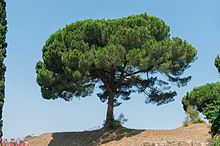
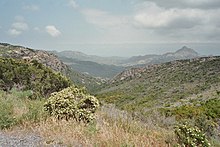
The vegetation in the area around the Mediterranean was created by climate change and natural selection in the Tertiary. With the end of the Ice Ages, the summer-dry, subtropical climate type set in in this region, so that moisture-loving plants were pushed to the north and - depending on the biotope - evergreen hard-leaved plants or conifers became dominant. Though the original vegetation is difficult to determine due to millennia-old human intervention, it is likely that the Mediterranean basin was once completely covered by forests of these species. Typical representatives are the holm oak (Quercus ilex) and the cork oak (Quercus suber) in the west, the olive tree (Olea europaea) and the carob tree (Ceratonia siliqua) in the east . In more humid areas, remnants of laurel forests have been preserved to this day . Pine , cypress and cedar trees dominate the higher lying coniferous forest level. Deciduous trees such as elm , poplar , plane and chestnut are common in the floodplains and river valleys. The boundaries of these forms of vegetation are formed by moisture in the north, drought in the south and east, and cold at high altitudes.
Since the first advanced civilizations, this form of vegetation, which can hardly be used by humans, has been on the retreat into inaccessible areas with poor soil quality. In the wake of clearing , grazing or fire (which also occurs naturally after a lightning strike), a degenerate form of the hardwood forest forms. This secondary forest only reaches a height of 5 meters and is significantly more species-rich, as dense to impenetrable undergrowth can flourish here. It is generally referred to with the word Macchie , which comes from Italian, but has its own name in each language area. The strawberry tree (Arbutus unedo) , tree heather (Erica arborea) and the evergreen oak species that have degenerated into shrubs thrive here , often also the real bay laurel (Laurus nobilis) and the mastic bush (Pistacia lentiscus) .
The more intense the overexploitation , the lower and lighter the vegetation becomes: the next stage of degeneration is the garrigue , whose shrubs and dwarf shrubs are no more than a man's height. Tree species are now only found in crippled form, the ground is often loosely covered with gorse bushes and herbs such as mint , thyme , sage , lavender and rosemary . In extreme cases, bare rock can finally emerge via the stage of dry grass lawn, which only offers a habitat to a few resistant species in crevices.
This development is reversible to a certain extent, but only as long as a sufficient humus cover is maintained. If this erodes due to a lack of root penetration, rock strips form, mostly karst landscapes on limestone , and so-called badlands on soft subsoil , in which draining water digs deep gorges. These areas are lost to human use.
The vegetation in steppe climates is determined by succulents, thorn bushes and other xerophytes. Halfagras (Stipa tenacissima) , Christ thorn (Zizyphus lotus) and wormwood (Artemisia inculta) are endemic species, and introduced plants such as opuntia and agave are very widespread . Characteristic is the surge in vegetation in the wet season, when many annual plants bloom briefly and intensely.
Wildlife

The fauna in the Mediterranean area is originally very diverse. In the high altitudes, especially of the Atlas, part of the original large fauna has been preserved: Brown bears , wild cats , wild boars , jackals , foxes , deer and some wolves live here . The diversity of bird species is also striking, the majority of which are migratory birds - there are three to four migration routes for migratory species in the Mediterranean region alone. You can find various types of eagles , hawks and owls , game such as pheasant , partridge , guinea fowl and an immense number of songbirds. Pelicans , flamingos and cranes have their territory near wetlands . Swallows, especially the house martin , are widespread .
The small fauna is characterized, among other things, by a large number of reptiles . Lizards , snakes and turtles live in the Mediterranean area. Articulated animals are also more abundant than in Northern Europe. In contrast, animals living below the ground cover are rather rare.
The Mediterranean is natural home to a range of domestic animals such as donkeys , sheep , goats, and pigeons . These live domesticated, but also wild or wild. Wild cats and dogs are particularly common near settlements. Due to human influence, species that were originally native to the Mediterranean area can no longer be found today. Examples are lion , crocodile and the aurochs, which were extinct in the 17th century .
Marine ecosystem
The Mediterranean itself is also extremely rich in species. On the one hand there are numerous species of fish such as sardines , tuna , swordfish , sharks and sea bream , and on the other hand immigrant or endogenous marine mammals such as dolphins and various types of whales . Animals such as sea urchins , octopuses , mussels , crabs and sea snails can also be observed in high biodiversity. Due to the warm, above-average salty water, which also has a low exchange capacity with the Atlantic, the supply of nutrients and oxygen in the water is low. As a result, there is a high selection pressure , but in the numerous ecological niches - similar to the land - few individuals per species are formed.
The Mediterranean has been a motor of evolution for millions of years . Due to the extremely narrow connections to other seas, it is, so to speak, an incubator that is in exchange with neighboring waters. For example, an increasing mediterranization of the Black Sea is currently being observed, which is often attributed to water warming as a result of climate change . The reverse migration is also possible: the marine mammals presumably entered the Mediterranean Sea via the Strait of Gibraltar .
Human interventions
For thousands of years the Mediterranean area has been shaped by cultivation and use by humans, so that in large parts the original flora and fauna can no longer be reconstructed. In view of the long-lasting, ever increasing influence, a large number of ecological problems have arisen, which in some regions threaten to assume catastrophic proportions. The Mediterranean is one of the most polluted seas on earth.
Forest destruction
Even in pre-Christian times, uncontrolled logging resulted in the irretrievable destruction of many forests: Phoenicians and later Romans used the cedar stocks in the Lebanon Mountains and in the Atlas to extract timber, as cedar wood is very hard and robust. It was mainly used for shipbuilding. Firewood in populated areas exacerbated the problem.
As the population increased, there was also an enormous expansion of the agricultural area, as a result of which the forests decreased in area in the course of massive clearing. The local population was pushed back into the difficult-to-access, previously intact forest areas and had to survive there. As a result, they were also damaged by human use, in particular by uncontrolled forest pasture.
Forest fires are a particularly noticeable factor damaging forests . These occur naturally, for example through lightning strikes, so that some plants have already adapted to them. Occasional fires even ensure a better exchange of the biomass . Due to human influence, however, forest fires have taken on such drastic forms that the regeneration of forest stands is often impossible. If the interval between two forest fires was between 20 and 100 years under natural circumstances, it is much shorter today. In Sardinia more than 20 fires per 100 km² are counted annually.
Forest fires have increased, among other things, because human settlement has become very dense. Careless use of open fire is the main cause, and economic motives such as land speculation and even political motives (forest fires as a sign of protest, e.g. in Corsica) are the reasons for increasing arson in recent times.
Soil degradation
Intensive agriculture in summer-dry areas almost inevitably leads to a deterioration in soil conditions: Since there is no longer sufficient rooting of the soil, wind and, above all, water erosion increases . Heavy rain in the winter half-year wash away the soil that is no longer held by the roots and quickly becomes saturated with liquid. Summer drought causes the remaining soil to dry out faster.
This cycle has meant that former "granaries" such as Sicily and the Maghreb can no longer secure their food supply on their own. The landscape is characterized by dry cultivation, some of which has fallow land for several years . The Po Valley, which is humid in summer, is an exception. In the remaining areas, attempts were mostly made to alleviate water shortages by irrigation , which in most cases led to a dramatic drop in the water table. These areas are now massively threatened by desertification. These effects are mitigated by winter precipitation, which prevents permanent soil salinization, but dry years can lead to the complete loss of cultivated land.
About half of the Mediterranean region suffers from severe to very severe soil degradation . Although the long-term consequences cannot yet be estimated, it is assumed that they can cause more far-reaching damage than general global warming.
Emissions
In a sensitive ecosystem, pollutant inputs can have serious consequences. Since the Mediterranean area was relatively densely populated early on, the consequences of environmental pollution have been observed for a long time. Population explosion , industrialization , motorization and modern agriculture have led to the fact that emissions have continued to rise and that individual biotopes are now considered to be endangered.
The Mediterranean in particular is suffering from increasing poisoning. In the less developed countries in Africa and the Middle East, untreated urban wastewater is the main factor, while in southern Europe it is the input of agricultural and industrial wastewater. Considerable amounts of heavy metals and chemical substances are carried into the sea via the Rhône and Po, but also via the smaller rivers . Extensive over-fertilization also leads to the inundation of nitrates and phosphates , which have repeatedly led to algal blooms in the Adriatic, which is particularly poor in exchange . The busy shipping and individual locations of oil ports and refineries also cause extreme pollution by mineral pollutants. Experts estimate the consequences of a possible tank accident as catastrophic, but even the status quo makes the organization Greenpeace fear that entire ecosystems will overturn. Since the water in the Mediterranean is exchanged on average only once every 80 years and the fresh water input is constantly decreasing due to agriculture and water management, this problem is exacerbated by itself every day. The considerably lower water quality leads to the closure of beaches every summer.
Introduction of species
A massive threat to biodiversity arises from man-made introduction of alien species into the Mediterranean ecosystem. This applies particularly to the Mediterranean Sea itself, which is illustrated by the example of the Suez Canal . Since its opening, thousands of species of tropical fish, jellyfish and shellfish have immigrated to the Levantine Basin, which has led to an extensive tropicalization of the eastern Mediterranean. In the absence of natural predators , these species spread at the expense of the original fauna and displace them. The problem is exacerbated by the release of ornamental fish and algae from aquariums as well as modern shipping, which pumps entire populations from foreign waters into the Mediterranean using drained ballast water . In this way, some biotopes are already affected by the catastrophic extinction of species.
history
The Mediterranean world has been one of the central world regions since the earliest times. In the countries bordering the Mediterranean Sea arose in antiquity . a. the advanced civilizations of the ancient Egyptians , Hittites , Israelites , Phoenicians , Greeks and Romans. Since the 1st century BC BC the Roman Empire united the Mediterranean in a political unit. This broke up first due to the division into a western and an eastern Roman half of the empire and finally in the 5th century under the onslaught of Germanic peoples (see late antiquity ).
After the conquests of the Arabs in the 7th and 8th centuries, the cultural unity of the area was gradually lost in the early Middle Ages . The Mediterranean continued to be an important bridge for trade and cultural exchange between Orient and Occident , but it also became the border between the Christian Occident in the north and the world of Islam in the south. The religious, but also economic and political differences escalated from 1096 in the crusades . After sea powers such as Venice and Genoa had long dominated the Mediterranean at the expense of the Byzantine Empire , they became in the 16./17. In the 19th century it was increasingly displaced by the empires of the Spaniards and Ottomans . Side conflicts arose from the piracy of the corsairs from the Maghreb and the Order of Malta . As a late consequence of the discovery of the sea routes to America and India at the end of the 15th century, the central geopolitical importance of the Mediterranean region declined in the 16th and 17th centuries. The power and economic centers shifted to north-western Europe and the coasts of the Atlantic . Only the opening of the Suez Canal in 1869 led to a renewed boom in shipping and trade. In recent decades, the double importance of the Mediterranean region as a bridge and cultural border between West and East - for example in Lebanon or in the Middle East conflict - has increasingly become the focus of global interest.
Christian Giordano describes one of the six historical regions of Europe as "Mediterranean Europe". In this context, however, only a large area is meant that extends from the Iberian Peninsula through southern France to southern Italy. The decisive common cultural characteristic is the lasting influence of the Western Roman Empire with its aristocratic structures and the latifundia agriculture of the aristocratic large owners. For centuries this region provided the north-west of Europe with food.
population
The Mediterranean area has been an above-average densely populated area since prehistoric times, which, due to its intercontinental location, was and is characterized by a wide variety of ethnicities, languages, religions and cultures. The exact number of inhabitants is difficult to give due to the delimitation problem; in 2005 it was roughly estimated at around 250 million inhabitants.
Population groups and languages

In the Mediterranean region there is a diverse ethnic composition: Arab population groups dominate North Africa and the Middle East up to the Turkish border, but do not form a homogeneous population there everywhere. In Morocco and Algeria in particular, indigenous peoples such as the Berbers form important minorities. In Israel, Jews make up the majority of the population, who in turn have immigrated from various homelands. Numerically rather insignificant European minorities can also be found in almost all Arab countries.
In its Mediterranean part, Turkey is ethnically relatively homogeneous. Besides Turks and Kurds, there are only tiny minorities of Greeks and Armenians . Most of them were driven out of the country during and after the First World War, but also until the 1950s (see also the genocide of the Armenians and the Greco-Turkish War ). The Kurds, as the largest ethnic minority, live on the Mediterranean coast mainly in the Adana and Mersin areas as the target area for many internally displaced persons. Towards the end of the 20th century, small communities of Europeans (especially Germans) permanently living there formed in the tourist centers of the Turkish Riviera in particular. Turks resettled from other countries or returning from guest workers also often settle along the Mediterranean coast.
In Europe the states and populations have been relatively congruent since the formation of the nation states. The end of the last official multiethnic state in the Mediterranean region, Yugoslavia , was accompanied by so-called ethnic cleansing, so that only Bosnia-Herzegovina has several equally strong population groups. In the EU countries Spain , France , Italy , Slovenia and Greece, however, only small official minorities are represented. The Catalans in Spain and the Corsicans in France, however, regard themselves as separate ethnic groups. Minorities in neighboring countries often live near the national borders, for example between Isonzo and Istria , where Italians , Slovenes and Croats mix. There are Albanian and Macedonian minorities in Greece, but their status is not officially recognized. Immigrant ethnic groups also play a role, especially North African guest workers, some of whom live in ghetto-like conditions in Spain and France . The Roma minority lives in all European countries. It represents at least 0.5% of the country's population, in some states more than 5%. The only divided state in the EU is Cyprus, the northern part of which has been de facto independent as the Turkish Republic of Northern Cyprus since it was occupied by Turkish troops in 1974 .
Many language groups are represented in the Mediterranean. The Indo-European language family dominates the European part, with Romance languages being common from Portugal to Italy. In addition to the national languages Portuguese, Spanish, French and Italian, there are still relics of formerly more widely used languages, such as Occitan in southern France , in some, mostly rural regions . Latin is the official language in Vatican City . Slavic languages like u. a. Croatian and Slovenian are spoken on the east coast of the Adriatic; Albanian and Greek represent their own Indo-European language branches. Malta is a special case: Maltese is spoken here, which is based on Creolised Arabic and has absorbed Italian and English influences. As a representative of the Semitic language family, Arabic dominates the area from Morocco to Syria, although it is spoken in different dialects depending on the region. Hebrew is the state language in Israel. With Turkish , a Turkic language is also common in the Mediterranean region.
English is the language of commerce and lingua franca these days, and French to a certain extent. The increasing importance of these languages has completely displaced one of the Mediterranean's very own commercial languages, the lingua franca , since the 19th century.
Population development

The population development in the Mediterranean area is characterized by strong growth along the coastal strips and population decline in the interior. The main reason for the associated internal migration is the increased number of jobs due to better economic development and diversity compared to the almost entirely rural parts of the country away from the coasts. The favorable climate, one of the factors for quality of life, also plays a role. The only exception to this development are the few inland metropolitan areas such as Madrid and Northern Italy , which have a long administrative or industrial tradition.
Natural population growth has steadily increased in historical times - with the exception of epidemics or wars - until it entered an exponential phase in the 20th century. Since then, the situation in Europe has become decoupled from the rest of the Mediterranean: In Italy and Slovenia, the population has declined after 1990, otherwise it has increased very slowly or stagnated. Albania alone is still growing at a rate of over 2% per year. In contrast, population growth in Africa and the Middle East continues unabated due to high birth rates and in Palestine reaches over 4% per year.
The Mediterranean region is affected by migratory movements for economic, and partly also for political reasons. While politically motivated migration is limited to the trouble spots (war refugees from ex-Yugoslavia and the Middle East), migration from poor to rich regions has assumed massive proportions since the 1990s. Unofficial immigration is particularly problematic for those countries that are close to considerably poorer regions, such as Spain (compared to Morocco) and Italy (compared to Albania).
Cities and metropolitan areas


The Mediterranean area is heavily urbanized and has a large number of agglomerations. Three of them are now (as of 2005) referred to as megacities : Istanbul (11.5 million), Madrid (6 million) and Algiers (5.5 million) each have over 5 million inhabitants in their agglomerations . Other agglomerations with over a million inhabitants are
- in Algeria: Algiers
- in Egypt: Alexandria
- in France: Marseille and Lyon
- in Greece: Athens and Thessaloniki
- in Israel: Tel Aviv-Jaffa
- in Italy: Rome , Milan , Naples , Turin and Palermo
- in Jordan: Amman
- in Croatia: Zagreb ( Rijeka and Split )
- in Lebanon: Beirut
- in Libya: Tripoli
- in Morocco: Rabat , Casablanca and Fez
- in the Palestinian Territories: Gaza
- in Portugal: Lisbon and Porto (both are on the Atlantic Ocean )
- in Spain: Madrid , Barcelona and Valencia
- in Syria: Damascus , Homs and Aleppo
- in Tunisia: Tunis
- in Turkey: Istanbul , İzmir , Bursa , Antalya and Adana
Only those metropolitan areas in the Mediterranean are represented in this list, although some borderline cases occur: The megacity of Cairo (agglomeration of 17.5 million inhabitants) is not far from the Mediterranean .
Some cities are characterized by particularly strong, sometimes uncontrolled growth. This affects the aforementioned megacities, but also other agglomerations, and has various causes. Antalya, for example, has increased its population almost fifteenfold in 40 years, especially as a result of mass tourism . Tirana with 800,000 inhabitants in 2005 has experienced a massive influx of rural populations after the end of the restrictive settlement policy of the Albanian communists and has doubled its population in less than 15 years. After Libya's economic opening, Tripoli experienced a doubling of its population in less than ten years. Metropolitan areas such as Gaza are growing primarily due to refugee movements and the natural birth rate.
religion
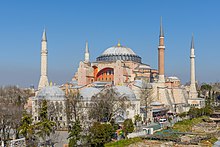
All three major monotheistic religions are represented or even originated in the Mediterranean region and look back on a long tradition.
The Judaism emerged around 1500 BC. Since then, it has had a checkered history that has repeatedly brought religion and its followers to the brink of survival. The beginnings of the religion are in the Middle East (today's Palestine and Israel, partly also Jordan); However, due to expulsion, deportation and migration, Judaism was largely only able to exist in the diaspora until the 20th century . The first modern Jewish state was not formed until Israel was founded. Jewish minorities were present throughout the Mediterranean for thousands of years and assumed important functions in economic life. Blooming communities in Spain, Portugal, Italy and Greece have been driven into exile , ghettoized or even destroyed in pogroms since the Middle Ages at the latest . Today only very small groups live in these countries, as the survivors of the Holocaust in particular emigrated to Israel or the USA .
The Christianity spread from the 1st century - originally as a splinter group from Judaism - from Palestine through Asia Minor, Egypt, Greece to the Roman heartland. After centuries of persecution, the Christians made their breakthrough in the 4th century with the Edict of Tolerance of Milan under Constantine the Great . In the course of the following centuries, contrasts between Western and Eastern Churches shaped the picture. This “Great Eastern Schism” was never lifted. The Reformation of the 16th century, on the other hand, could never gain a foothold in the Mediterranean. Christianity dominates in Europe, with the western and central parts up to Croatia being Roman Catholic and the Pope residing in Rome as the spiritual leader. The Greek Orthodox denomination is largely limited to Greece, the Republic of Cyprus , Lebanon and the coastal regions of Syria. Lebanon has notable Christian populations (mainly Maronites ), but they are otherwise very small in the Asian and African countries. Occasionally there are other Christian denominations such as the Syrian Orthodox Church and the Copts in Egypt.
The Islam as the youngest of the three religions spread in the 7th century in the Mediterranean and repressed in North Africa and the Levant, and later in Asia and parts of South Eastern Europe gradually the original religious communities. However, the Reconquista and the self-liberation of the Balkans have repeatedly pushed back Islamic influences in Europe. Only Albania is dominated by Islam in Europe, and Bosnia-Herzegovina also has a significant Muslim population. The majority of Muslims in the Mediterranean region are Sunnis , in Turkey over 18% describe themselves as Alevis . In addition, Shiites are particularly represented in the Middle East and Druze in smaller communities .
politics
The forms of government and government are diverse and are largely due to historical and religious traditions. While parliamentary democracies have been installed everywhere in Europe since the late 1990s , the same applies in the rest of the area only to Turkey and Israel. Authoritarian forms of government prevail in the remaining Islamic states. For these reasons, a political unity that encompasses the entire Mediterranean region is inconceivable in the long term.
State constitutions and administration
Even if the foundations of modern forms of government and administration largely originated in the Mediterranean region in ancient times, the current democratic and republican traditions are significantly more recent. Since the transition to divine emperorship in the Roman Empire, the region has been shaped for a long time by monarchies , aristocratic and feudal societies. Republican constitutions did not emerge until the Middle Ages in the rich trading countries of Italy (Genoa, Venice), but they were determined by a small class of merchants and did not really introduce democratic conditions. Democracy by today's standards only slowly gained acceptance after the French Revolution in 1789, accompanied by steady setbacks: The longest phase of uninterrupted democracy has lasted in France - apart from the times of foreign occupation - since 1871, in Italy since 1945, in Israel since 1947, in Portugal since 1975, in Spain since 1976, in Greece since 1980, in Albania and the former Yugoslav states even since the 1990s. After the end of the military dictatorship in 1981, Turkey established a formally democratic state, but real democracy only seems to be slowly establishing itself since the extensive reforms from 2003 (minority rights, freedom of the press, reform of the judiciary).
Monarchies have become rare in the Mediterranean. Parliamentary monarchies exist in Spain and in the miniature state of Monaco, while in Morocco the formal absolute monarchy still applies. Jordan is a monarchy with limited parliamentary powers. Special forms are the Vatican, which is governed as theocracy by the Pope with absolute powers, and Andorra, which has anchored a secular and spiritual dual leadership in the constitution. All other states are Republican. Systems prevail in the Arab countries that are based on the power of a mostly non-democratically elected president or a one-party dictatorship . This power is usually secured militarily. It is noticeable that these systems are mostly secular and that the domestic opposition is not mainly driven by democrats but mainly by fundamentalists. The separation of state and religion is most evident in the two democratically constituted and explicitly secular states of France and Turkey.
Conflicts and Cooperations

Interstate conflicts only play a subordinate role in the European part of the Mediterranean area and are settled through diplomatic means. Even on the Cyprus question , on which the positions between the Greek Cypriot government in the southern part and the Turkish-controlled northern part under the Denktaş government have not changed for decades, a peaceful solution seems to be in sight. The main reason for this is the EU expansion , in the course of which Turkey is striving for the status of an accession candidate and is implementing far-reaching political reforms for this purpose. With the exception of Bosnia-Herzegovina, Montenegro and Albania, the European Mediterranean countries have all been organized in the EU since the last expansion in 2013 (the smallest states without formal membership status). Since the European crisis in 2005, however, the admission of Turkey seems to be receding into the distance. Militarily, on the other hand, Turkey has achieved integration with the West since 1952 when it joined NATO .
For the most part, there is also a cooperative relationship between the Arab-Islamic countries that are politically and culturally close. For the most part, they are organized both in the Arab League and in the Islamic Conference OIC . The African states except Morocco are also members of the African Union . The relationship between Arabs and Turks is much more difficult, as they differ greatly in language, ethnicity and culture and also pursue different economic and geostrategic goals. The relationship between Turkey and Syria, in particular, is fraught with conflict: on the one hand, they have repeatedly been on the opposing side in conflicts in the Middle East (particularly in the Gulf Wars ), and on the other, a conflict over the water reserves of the Euphrates has been simmering for a long time . The Syrians suspect Turkey of excessively straining the upper reaches by installing reservoirs and thus developing a strategic weapon because Turkey can "turn off the tap" if necessary.
Important international co-operations exist between different nations beyond the international framework ( UN , WTO ): The European countries are organized in the Council of Europe and the OSCE , the EU states also in the WEU . The OECD also has Turkey and Israel as members. States that are not militarily organized in NATO belong to the majority of the Non-Aligned States ( NAM ), which, however, got into a fundamental strategic discussion after the settlement of the East-West conflict. The oil-exporting countries Libya and Algeria are also represented in OPEC .
The main conflict in the Mediterranean is the Middle East conflict. After turning a large area from Tunisia to Iran into an explosive crisis area for decades in the 20th century, since the late 1980s he has focused primarily on Israel and its immediate neighbors. There, however, it has increased in strength since the beginning of the second Intifada and could not be settled despite multiple mediations by European, American and international representatives. The situation is also uncertain in Lebanon, where there have been anti-Syrian riots and assassinations since 2005, which rekindled the civil war and the Israeli-Lebanese border war in the following year.
Structural problems
Structural political problems are often mutually dependent and mainly affect the following areas in the Mediterranean region:
- Economic disparities and migration. The “fortress EU” cannot be secured against illegal immigration in the Mediterranean area either. Cooperation between countries of origin and destination is not in sight for the foreseeable future. Destination countries treat the problem differently: while Spain is striving to legalize the residence of immigrants, Italy's attempts to avert it are sometimes of a military nature.
- Organized crime . Organized white-collar crime manifests itself in mafia- like structures in south-eastern Europe and Italy and has increased significantly in intensity and potential for aggression since the late 1990s. Naples, for example, is once again considered firmly in the hands of the Camorra . The problem of people smuggling and drug smuggling is also significant, and is still increasing despite the occasional successful search. The reason for this is the economic north-south divide.
- Terrorism . In addition to terrorist organizations in the crisis area of the Middle East (see Middle East conflict ), the Mediterranean area is endangered by attacks by separatist and religious-fundamentalist groups. To the account of Al-Qaeda go a number of attacks in Madrid, Istanbul, Casablanca and on the Tunisian island of Djerba , called together many hundreds of deaths. The target of terrorist activities are also tourist facilities that exist throughout the Mediterranean region and guarantee maximum effect in relation to the effort: they are difficult to secure and every attack leads to far-reaching consequences for the state under attack by reducing bookings. Religious fundamentalist terror by the GIA and other groups is at times a factor that threatens the entire state in Algeria. Significant separatist terrorism comes from the Basque ETA and, to a lesser extent, from the Corsican FLNC .
- Corruption . Some of the countries in the Mediterranean region achieve very low index values on the corruption scale published annually by Transparency International . On a scale from 0 (extremely corrupt) to 10 (corruption-free), according to the 2004 study, France, Spain, Malta, Israel, Portugal, Slovenia, Cyprus and Jordan achieve index values above the mean in this ranking, Tunisia has a value of 5 .0 and even ranks ahead of Italy. The Palestinian territories, Libya and Albania are the hardest hit and are among the most corrupt nations in the world with an index value of 2.5 each.
- Human and civil rights violations. These are naturally most pronounced in non-democratic states, but systematic state persecution occurs in many regions. The greatest progress in this regard can be seen in Turkey. A growing problem, according to Amnesty International, is the fight against terrorism in authoritarian states, which is linked to arbitrary arrests, unfair trials, torture and ill-treatment. The death penalty is still carried out almost everywhere there.
economy
The Mediterranean economy has long been characterized by diversified agriculture, trade and transport. Industrial focuses have remained seldom to this day, but the service sector has developed strongly throughout the region. Tourism plays a particularly prominent role here .
Overall, the Mediterranean is a growth region, but the growth rates differ greatly between countries. Economic output in the EU countries is significantly higher than in the rest of the countries, but within the EU the regions in the Mediterranean basin are for the most part structurally weak. Therefore, there are very many recipient areas of EU structural aid in the Mediterranean area. In Europe, Spain, Portugal, Italy and Greece are often casually referred to as “Club Med”. The term arose when the Maastricht convergence criteria were established in 1992 , which required great efforts for the southern European countries. There were public debt and inflation particularly pronounced during the economic performance was relatively low.
Agriculture, forestry, fishing
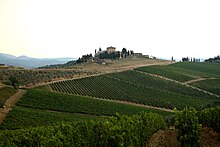

Due to its climate and natural resources, the Mediterranean region is still strongly characterized by agriculture. Within the EU, almost all regions located there are characterized by an above-average primary sector . The southern and eastern neighbors sometimes even generate more than half of their GDP from agricultural value added.
Grain cultivation plays a major role in agriculture, which is intensively practiced in the Po Valley ( wheat and rice cultivation ) and extensive in North Africa. In addition to wheat, maize is increasingly being grown , and in Africa sometimes millet is also being grown. However, the deterioration of the soil has made large areas less profitable for grain cultivation.
The wine-growing has a down to the ancient Greeks standing tradition in the Mediterranean region. Today it is widespread throughout the metropolitan area; Overproduction of cheap wines goes hand in hand with specialized cultivation in top locations. Italy, Spain, France, Portugal and Greece are leaders in wine production, but there are also growing areas in North Africa, Turkey and Lebanon. The other great agrarian tradition is olive growing . Olives are mostly processed into oil, which in turn is used as edible oil or as a raw material for other products such as soaps and creams.
In the vicinity of rivers, an intensive irrigation culture with specialized fruit and vegetable cultivation has largely developed . Some fruit and vegetables are also grown over the winter - under tarpaulins or in greenhouses. A prime example is the Spanish cultivation principle of the Huerta, an intensive garden culture along the river valleys and estuaries. In the north, peaches , apricots , melons , cherries and plums dominate , further in the south mainly citrus fruits , and in particularly warm partial climates even bananas and dates . Vegetables are mainly tomatoes , as well as aubergines , artichokes , peppers and cabbage .
Special cultures are common in the Mediterranean. Tobacco cultivation is widespread . Large areas of cotton are grown in the coastal plains of southern Turkey . The Mediterranean plants containing essential oils play an important economic role as herbs , spices and the basis for fragrances. The lavender fields in Provence are world famous.
Due to the limited space available and the dense population, animal husbandry is concentrated on small animals that can be kept within a delimited territory and individual specimens of larger cattle. The former include poultry , pigs and rabbits, which have ensured the meat supply since ancient times, the second group consists of pack animals and mounts such as donkeys and horses, but also cattle, which in older times were mainly used as draft animals. In Spain, cattle farming has also developed for bullfighting purposes . In contrast, sheep and goats in particular were herded and were the main source of milk and milk products. This traditional cattle breeding has largely been preserved in the south, whereas in Europe the proportion of cattle breeding has increased at the expense of sheep and goat farming. Beekeeping also plays a prominent role in the entire Mediterranean region.
In the course of forest destruction, the importance of forestry has also lost weight. Timber production from Mediterranean forests is now insignificant as an economic sector. The hunting no longer plays a role in much of the region. Wherever it is practiced, it largely exacerbates ecological problems: For example, the largely uncontrolled recreational hunting in the Rhône delta endangers the animal population in the Camargue National Park through kills and lead-containing cartridge residues . However, there are also examples of sustainable forest management. In Spain and Portugal, for example, almost the entire world production of cork is concentrated from the cork oaks endemic there. The free-standing trees with an undergrowth-free environment create ideal conditions for hares and their predators, such as the Iberian eagle, which are also endangered. Tree resin is extracted from Mediterranean forests, especially from pine trees , which plays a certain role in the manufacture of fragrances and candles. Truffles are found in oak stocks in some regions.
The fishing is an important industry for the Mediterranean. The per capita consumption of fish is relatively high, but varies from country to country. Popular catch fish are tuna, cod, sardines and anchovies, which are either sold fresh or processed. Mussels and seafood are also fished, with sponges playing an important role off the African coast. However, overfishing combined with high demand is increasingly making the region an importer of fish. The North Atlantic, which is mainly navigated from Portugal and Spain, is much more productive than the Mediterranean.
Raw materials and mineral resources
Clay , earth and stones are an important sector of raw material extraction with a long tradition in the Mediterranean region. Clay pits provide the raw material for a diverse ceramic industry, particularly in Italy, Spain and Portugal. In quarries mainly limestone, but also marble of first class quality is extracted. Marble in particular (e.g. the snow-white Italian Carrara marble) enjoys a worldwide reputation. In addition, especially in North Africa, phosphate is obtained on a large scale as a basis for plant fertilizers.
In comparison, mining is almost insignificant. Although a large number of mines were operated in ancient times and copper , iron , tin and later also aluminum were smelted here first, the Mediterranean area is very poor in raw materials for today's extraction conditions. The oil-exporting countries Libya and Algeria do not get their raw materials from the Mediterranean part of the country, but from the interior of the Sahara. Only the production of mercury in Spain and Italy accounts for a significant share of world production.
Industry and craft

Industry is underrepresented in the Mediterranean compared to other regions of the world. Heavy industry is practically absent, but the consumer goods industry, at least in the European part, is quite well developed and heavily concentrated on individual sectors. In the southern Mediterranean region, handicrafts - often still traditionally practiced - dominate . The secondary sector has different focuses:
- Metal processing has developed in Spain and Italy, and for some time also in Turkey . In particular, the vehicle construction and its supplier industry is important at some locations. B. in Turin ( Fiat ), Valencia ( Ford ) and Barcelona ( Seat ). The aircraft industry also has a mainstay in Spain. The ship , once synonymous is operated in the Mediterranean only in Greece and Italy on a large scale. The Croatian port city of Rijeka also has a long tradition of shipbuilding. Other branches of metal processing are precision engineering and watchmaking (especially in Italy).
- Due to the staffing intensity of the textile industry , its spread has mostly shifted to countries with low wages. Textile centers can still be found in Spain and Portugal, but above all in Turkey and now also in North Africa. Italy still has a certain position in the manufacture of designer clothing and shoes, but it has specialized in the top price segment. In Turkey, Tunisia and Morocco, the manufacture of carpets has remained an important branch. Turkey is also a global exporter of all types of leather products.
- Large chemical sites are located in France, Spain, Portugal and Italy. Refineries and chemical industries also exist in North Africa. Libya has long been suspected of producing chemical weapons in its chemical factories . The pharmaceutical industry is also well represented in France and Italy. A momentous accident occurred in Seveso , Italy , in 1976 when the massive release of dioxins terrified the city.
- The energy supply is based on a diversified mix: In the Rhone Valley in particular, there are some nuclear facilities that contribute a large part to the French electricity supply. In addition to the usual fossil-based power plants , the abundance of sunshine in the Mediterranean is also crucial for the development of solar power plants. The focus here is the central plateau of Spain. A significant part of the national energy consumption is covered there by hydropower plants. Due to the dense population and the development of tourism, households are the main consumers of energy. Due to the high energy consumption of the air conditioning systems and falling water levels in reservoirs, especially in summer, drought and heat lead to the fear of bottlenecks or even network breakdowns.
- The construction industry is booming in most of the Mediterranean countries, which is primarily due to population and economic growth, and in particular to the establishment of tourist infrastructure.
- The processing of agricultural products in the food industry is particularly diverse . This applies to wine filling, distilleries , canning , oil mills, large bakeries and pasta production, meat and fish processing as well as the production of ready meals and confectionery . A major branch of industry has specialized in the production of luxury items. In particular, the good reputation of most of the national gastronomy and the Mediterranean cuisine as a whole is very beneficial to the sale of these products.
- Due to the spatially small and very diverse extraction of various natural resources, niche productions have also established themselves in individual countries and their regions. In Portugal, for example, the manufacture of bottle corks and tiles is of particular importance. France occupies a leading position in the manufacture of perfumes and soaps. Cosmetics are also produced in abundance in Spain and Italy. These two countries are also important furniture manufacturers . In the North African and Oriental countries, on the other hand, a diverse tradition of handicraft has been preserved. Durable goods are mainly produced for the local markets, and especially handicrafts and jewelry for export .
tourism
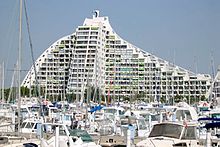
The Mediterranean is an almost ideal area for all types of tourism . Therefore, this service branch is the one that is growing at a breathtaking pace in almost all countries.
Tourism in the Mediterranean region has a tradition that goes back to the educational trips of wealthy citizens in the 18th century. The main reasons for the creation were the pleasant climate, the scenic and the cultural attractions. At 55,000 kilometers, the Mediterranean also has more coastline than z. B. the entire African continent, whereby a corresponding volume potential could develop. While the travel activity was initially limited to glamorous seaside resorts and cultural metropolises, there was a boom in individual and later also in package tourism in the period after the Second World War , which continues to this day. The individual regions have developed differently:
- Western Mediterranean ( Spain , France , Italy ): In the 1950s, the Adriatic coast was the preferred travel destination for Germans due to its quick accessibility by car - Rimini was then known as the “Teutonengrill”. In the 1960s and 1970s, package deals by bus and increasingly by plane began to appear, increasingly heading for Spain, where the cost of living was cheaper.
- Eastern Mediterranean ( Croatia , Montenegro , Greece , Turkey ): The Istrian and Dalmatian coasts in Croatia as well as the Croatian islands established themselves as the most popular travel destinations in Southern Europe in the 1960s . Above all, camping and family vacations are paramount here. Cities like Rovinj or Dubrovnik became world famous. Since the end of the Balkan conflict (1995), Croatia has experienced a real boom. With over 8.5 million foreign visitors in 2005, Croatia ranks eighteenth among the most popular holiday destinations in the world. The Republic of Greece established itself as a destination primarily for more individual travel ideas. The Greek islands in particular are attractions for visitors from all over the world. The Republic of Montenegro was already a well-known and popular travel destination in Tito's time. Tourism in the regions came to an almost complete standstill as a result of the events in the 1990s. Since the independence from Belgrade (2006), the small country has been increasingly featured in travel catalogs.
Today, destinations of the lower and highest comfort class are distributed throughout the region and often right next to each other, of which Mallorca ( Port d'Andratx for the upper class, s'Arenal for mass tourism) is a good example. Some countries, such as Malta, derive the majority of their GDP from tourism income. Only a few areas suitable for this are not developed for tourism. The reasons lie in political instability and a lack of security (e.g. Algeria , Syria , Lebanon ), political unwillingness (Libya) or a lack of economic efficiency ( Albania ). In some regions, the destruction of natural landscapes and infrastructures is increasingly being taken seriously as a problem and tourism is being pushed back or limited by the public.
other services
In addition to tourism, trade and transport play a prominent role in the entire Mediterranean region. The marketing and transport of agricultural products and their products has a long and successful tradition. Jaffa oranges, Italian noodles and Spanish Serrano ham are examples of successful marketing in German-speaking countries. Within Europe, the majority of goods are transported by road, between the continents almost exclusively by ship. As a result, freight terminals have emerged in the entire Mediterranean area , which are the locations of large freight forwarding companies and primarily handle containers.
Italy and Spain are powerful financial centers with a highly developed banking and insurance system. While in Spain it is mainly the banks (e.g. Banco de Santander ) that belong to the world league, Italy has a few insurance giants (e.g. Generali ) to offer. The telecommunication developed very far in both countries. Israel, on the other hand, is an international leader in software development .
Science and culture are important public services in the Mediterranean.
traffic
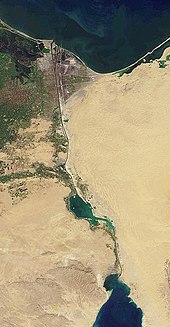
Due to its very convenient location, the Mediterranean area is the destination and transit station for all types of transport. A special feature is that the region does not present itself as a compact land mass, but consists of neighbors of a common sea, so that shipping has always played a much more important role here than in comparable economic areas.
Maritime transport
While coastal shipping only serves tourist demand, passenger and freight connections across the Mediterranean have steadily grown in importance. In terms of freight volume, the Mediterranean has been particularly important as a transit area since a connection to the Indian Ocean was established via the Suez Canal in the 19th century. This and the Strait of Gibraltar as a natural connection to the Atlantic are among the busiest shipping lanes in the world. In particular, oil transports from the Persian Gulf are handled here.
The transportation of people is also important. Since the end of the colonial era, this has been mainly shaped by tourism. Previously, for example, daily ferry connections were maintained on the route Marseille - Algiers, which represented an important bridge between France and its North African possessions. The main ferry connections today concern more goods and people traffic within the EU ( Messina - Reggio Calabria or Bari - Patras ).
Rail transport
As early as the end of the 19th century, the Mediterranean was the scene of various prestige projects that were supposed to connect Europe with the Middle East by rail. The Baghdad Railway , which crossed all of Turkey and ran along the Mediterranean Sea via what is now Syria, was largely made possible by German funding. A legendary passenger route is the Orient Express to Istanbul, which no longer operates today.
Railways can be found in almost all Mediterranean countries, with the density being highest in Europe. The North African routes were often built in the colonial era and are still operated today by the respective national railway companies. On the most frequented routes with sea connections, entire trains can be transported in special ships.
The lane changing stations on the French-Spanish border are a specialty . Due to the different gauge of the respective railway networks, there is an interface with a mandatory train change, so that the border stations in Hendaye and Irún as well as Cerbère and Portbou appear grotesquely oversized in relation to the size of the places.
Road traffic
A network of roads has been running through the Mediterranean region since Roman times, connecting all the important settlements and being essential for the transport of troops and goods. Some of the streets and an astonishingly high number of bridges and viaducts have been preserved to this day. After a second wave of militarily motivated road construction began in the western Mediterranean under Napoleon, motorization in particular was decisive for today's road density. In Italy, in the immediate post-war period, in the other EU states at the latest since their accession, the increased construction of motorways began, most of which are toll roads in the Mediterranean region . The Spanish domestic connections, which were financed almost exclusively through EU funds, are an exception.
Most of the coast between Slovenia and the Levant is so steep that road access is very difficult. Here, through traffic is usually routed through cheaper regions inland, while access to the coast is via a few spur roads, some of which have to be led over dizzying pass heights . Difficult crossings of high mountains regularly lead to traffic bottlenecks, which are a serious problem, especially during the main travel season.
Road traffic in the Mediterranean region poses particular stresses and dangers: The emissions have a negative impact on the health of the population, especially in areas where settlement space is scarce and roads often lead through inner cities . The enormous volume of traffic and irregularities in terms of labor law also increase the risk of serious accidents. A large number of tourist buses or trucks regularly crash due to the fatigue of their drivers, which regularly leads to high death rates.
air traffic
Air traffic in the Mediterranean is on a constant upswing. This development is also mainly due to tourism, especially mass tourism. In addition, air connections are increasingly being used by migrants when they commute between the host country and their home country. The cause is the drop in prices, which makes individual travel unnecessary on the main routes in terms of time and costs.
With the exception of the smallest states, every Mediterranean country has one or more airports . While some owe their existence almost exclusively to tourism (Djerba, Agadir , originally also Antalya), others have developed into large transit centers that have taken over the distribution of passengers across the Mediterranean and beyond. In Europe excluding Turkey, the largest airports in terms of passenger volume are Madrid (fifth largest European airport), Rome and Barcelona in that order. Other major airports are Athens, Istanbul, Tel Aviv, Tunis and Casablanca.
Culture
Intercultural exchange, intellectual traditions and an early developed urbanity have made the Mediterranean area a particularly culturally important area. Classical philosophy was developed here, democracy and republic were invented, and a number of world-famous libraries and universities were founded. The fine arts and architecture were also always highly regarded and strongly promoted by all cultures.
art
Today, the cultural foundations that arose in the Mediterranean region are widespread worldwide - the same can be said about the works of art, not a few of which are housed outside the region in the Louvre , the Pergamon Museum , the British Museum or in US collections. The classic artistic epochs of ancient Greece and the Roman Empire are genuinely Mediterranean, and they are very similar in terms of content and design, as the Romans had adopted most of the Greek stylistic devices.
The regional art movements began to diverge from the 8th century: The Islamic areas developed a very differentiated ornamentation and a characteristic Moorish architectural style, which was so formative that it repeatedly influenced Christian culture. In Europe, the Romanesque and subsequently the Gothic developed as occidental, strongly architecturally oriented art forms that were particularly influential in sacred and military buildings. In Byzantium a very unique, primarily Greek-influenced art form developed, which was far superior to the Western one in terms of visual representation.
Art in the Mediterranean area gained a special dynamic with the emergence of the Renaissance in Italy, when painting was revolutionized and massively promoted by investors. The architecture was completely redesigned and differentiated into many regional styles (e.g. Manueline style in Portugal). The Baroque was also largely based on the Italian cultural area, but also influenced Spain. During this period, Spain contributed greatly to the development of art in Europe with some outstanding painters such as Diego Velázquez .
Modernity has also initiated some important directions in the Mediterranean region. Pablo Picasso and Juan Gris shaped Cubism , Antonio Gaudí his own Expressionism , and Futurism developed in Italy . Development stalled in these countries when they came under fascist regimes and ceded their cultural leadership role (including most of the artists) to the southern French region in particular. This had previously been a meeting point for a large number of mainly Impressionist artists such as Paul Cézanne , Paul Gauguin and Vincent van Gogh , who greatly appreciated the climate and the lighting conditions in the Mediterranean.
Arabic art: ornamentation in the Alhambra , Granada
"The Creation of Adam", Renaissance work in the Sistine Chapel , Rome
Paul Cézanne :
"The sea at L'Estaque"
Attractions

As an ancient cultural area that has developed over thousands of years, the Mediterranean region has countless cultural monuments, of which more than 150 are included in the list of UNESCO World Heritage Sites . A considerable number of metropolises have been settled continuously for 2000 to 3000 years and have pioneering buildings from all style-defining epochs. Particularly noteworthy are:
- Rome, which as the “Eternal City” has a history of almost three thousand years and houses countless buildings of inestimable cultural value from Roman times.
- Jerusalem, the only city that is viewed as a spiritual center by three world religions and therefore combines Christian, Jewish and Islamic buildings in a very small space.
- Istanbul, which experienced one after the other Roman, Christian and Islamic eras, the evidence of which can be traced everywhere.
In historical times, the centers of power and states have shifted and formed again and again, so that certain stylistic epochs are also regionally concentrated. Examples of outstanding cultural monuments are:
- from the early days: Knossos (Crete), Troy and the Lycian tombs (Turkey), Carthage (Tunisia)
- from classical and Hellenistic Greece: the Athenian Acropolis , Delphi (Greece), Aspendos (Turkey), Taormina (Sicily), the city complex of Alexandria (Egypt)
- from Roman times: Roman Forum , Colosseum , thermal baths , palace ruins and the forerunners of Castel Sant'Angelo in Rome, aqueducts ( Pont du Gard , Segovia ), arenas ( El Jem , Arles , Nîmes ), theaters ( Orange ), temples (Maison Carrée in Nîmes ), City facilities ( Ostia , Pompeii ), military buildings (city wall of Jerusalem), the amphitheater in Pula and the Diocletian's Palace in Split , Croatia
- from the Middle Ages: Romanesque and Gothic cathedrals in Spain and Portugal ( Burgos , Seville , Braga ), castles ( Castel del Monte , Carcassonne , Papal Palace in Avignon, Krak des Chevaliers in Syria and Templar castles in Malta and Cyprus), city complexes (Venice, Siena , Residential towers in San Gimignano , fortifications of Ávila ), Moorish architecture in Spain ( Alhambra in Granada , mosques in Toledo and Córdoba ) and North Africa (Fez, Medina of Algiers), Byzantine sacred buildings ( Hagia Sophia in Istanbul). The Ottoman Bridge Stari Most in Mostar and the Ferhadija Mosque in Bosnia-Herzegovina . The old town of Dubrovnik with its Romanesque and Gothic churches, palaces and monasteries in Croatia.
- from the Renaissance: sacred buildings ( St. Peter's Basilica in Rome, Florence Cathedral ), secular buildings ( Uffizi in Florence), palaces ( El Escorial near Madrid), military buildings ( Torre de Belém in Lisbon). The Cathedral of Saint Jacob in Šibenik , Croatia
- from the baroque era: city structures (Turin New Town, Sicilian cities, Plaza Mayor in Madrid, Valladolid , Salamanca ), cathedrals ( Saragossa , Coimbra , Lisbon), fortresses
- From the later modern period: Art Nouveau buildings in Spain (especially Barcelona ), as well as in Croatia, Opatija , with its villas and luxurious hotels.
- Modern architecture (Art Nouveau): cityscape of Barcelona with Torre Agbar skyscraper, Diamond of Istanbul skyscraper in the financial district of Istanbul, Viaduc de Millau in southern France, Olympic Sports Complex Athens and Acropolis Museum in Athens , Poljud Stadium and Sports Complex in Split, Franjo Tuđman Bridge in Dubrovnik and the White City (Bauhaus) in Tel Aviv
gastronomy

Within the zone of the Mediterranean climate, its own gastronomy has developed, the Mediterranean cuisine . This is characterized by the main use of vegetable oils, especially olive oil . Since olive oil has a high proportion of unsaturated fatty acids , it is considered digestible and health-promoting. In addition, the Mediterranean cuisine is characterized by a high proportion of vegetables and fruit and the abundant use of typical herbs and spices. Traditionally, a relatively large amount of fish is also consumed. All of these characteristics have contributed to the fact that this gastronomy has become very popular worldwide, as it is perceived as extremely healthy and tasty. The traditional, regular consumption of moderate amounts of wine also combines health with pleasure.
There are differences in gastronomy in the Mediterranean area for climatic, religious and economic reasons: those areas in which no olive trees thrive (mountainous areas, northern Adriatic and Po plains, in the south the steppes) have not been able to develop a characteristic Mediterranean cuisine. Religious backgrounds mainly concern the lack of certain types of meat: pork, for example, is traditionally only used in Christian countries. A specialty is the Jewish cuisine, which has developed its very own character through various specifications regarding kosher preparation. Economic reasons relate primarily to the availability of appropriate natural resources: In the interior of the Iberian Peninsula, for example, a lot of meat is consumed, while on the Portuguese coast mainly fish is on the menu.
Some dishes from the Mediterranean cuisine have found their way into fast food gastronomy, which is why they are often no longer viewed primarily as Mediterranean. Typical for this are the pizza , Ćevapčići or the doner kebab , some of which develop independently outside the Mediterranean area and sometimes even lose their original character.
Some national cuisines enjoy a particularly good reputation: French and Italian cuisine are among the most influential national cuisines in the world and have been recognized as an intangible world cultural heritage by UNESCO. The characteristics of the country kitchens are roughly as follows:
- Albania: sheep cheese, raki (schnapps)
- Arab-Islamic countries: Meat, milk and milk products from sheep, camels and goats, dishes based on chickpeas ( hummus ), millet and wheat groats ( couscous ), meat skewered ( shish kebab ), fried dishes (e.g. brik )
- Balkan region: rice dishes, Ćevapčići and grilled meat of all kinds, pita, burek, bean soup / stew (pasulj), slivovic (schnapps)
- Greece: fish of all kinds, seafood, octopus, meat and cheese combinations, stuffed vegetables / vine leaves, taramosalata , spanakopita
- Israel: hummus, gefilte fish , cholent , steak and eggplant salad ( mutabbal ), bagels , falafel , charoset
- Italy: Seafood , pasta , pizza , pesto , risotto , ice cream , panettone , tiramisu , various types of cheese such as Parmesan , mozzarella or Gorgonzola , sausage and meat products such as mortadella , salami , San Daniele ham or Parma ham .
- Croatia: Istrian and Dalmatian pršut and bacon , fish (including bakalar ), seafood, licki krumpir , kulen , lamb on the spit, grilled meat, zganci , wine ( Prosek , Dingač ), Travarica (schnapps), Kruskovac (pear liqueur), Krofne
- Lebanon: falafel , hummus, mutabbal, starters
- Portugal: fish of all kinds, seafood , bacalhau in various versions, kid, stews ( feijoada ), soups ( caldo verde ), pork dishes marinated in red wine ( vindalho )
- Spain: tapas , grilled meat (pork, lamb), ham, paella , salads
- Turkey: dishes on yoghurt base , Pastries, desserts, soups, fish dishes, lamb and mutton dishes, meats, stuffed vegetables / vine leaves
literature
- David Abulafia : The Great Sea. A Human History of the Mediterranean . Oxford University Press, Oxford u. a. 2011.
- Andreas Bärtels: Plants of the Mediterranean area . Ulmer, Stuttgart 2003, ISBN 3-8001-3287-7 .
- Matthias Bergbauer, Bernd Humberg: What lives in the Mediterranean? Franckh-Kosmos, Stuttgart 1999, ISBN 3-440-07733-0 .
- Fernand Braudel : The Mediterranean and the Mediterranean World in the Epoch of Philip II . 3 volumes. Suhrkamp, Frankfurt am Main 1994, 1998 (reprint), ISBN 3-518-28954-3 .
- Hans-Joachim Gehrke , Helmuth Schneider (ed.): History of antiquity. A study book . JB Metzler, Stuttgart / Weimar 2000, ISBN 3-476-01455-X .
- Ina-Maria Greverus , Regina Römhild, Gisela Welz: The Mediterraneans: Reworking the Past, Shaping the Present, Considering the Future . Anthropological Journal on European Cultures , vol. 10. LIT, Münster 2002, ISBN 3-8258-6114-7 .
- Ernst Kornemann , Hermann Bengtson (ed.): World history of the Mediterranean area. From Philip II of Macedonia to Muhammad . 2nd Edition. CH Beck, Munich 1967, 1978, ISBN 3-406-06775-1 .
- Klaus Rother: The Mediterranean. A geographical overview . Teubner, Stuttgart 1993, ISBN 3-519-03431-X .
- Jürgen Schultz: The earth's eco-zones . Ulmer, Stuttgart 1995, ISBN 3-8252-1514-8 .
- Horst-Günter Wagner: Mediterranean area . 2nd, completely revised edition. Scientific Book Society, Darmstadt 2011, ISBN 978-3-534-23179-9 .
- Horst-Günter Wagner: The Mediterranean area as a subtropical habitat. To develop ecological and socio-economic barriers to its development . In: Geoecodynamics. Volume 9. Bensheim 1988, ISSN 0720-454X , pp. 103-133.
- Horst-Günter Wagner: States in the south of the EU. Economic geography basics, problems and opportunities . Germany and Europe, No. 63, 2012, pp. 36–45.
Web links
|
Further content in the sister projects of Wikipedia:
|
||
|
|
Commons | - multimedia content |
|
|
Wiktionary | - Dictionary entries |
|
|
Wikivoyage | - Travel Guide |
- Center for Mediterranean Studies
- Database of indexed literature on the social, political and economic situation in the Mediterranean region
Individual evidence
- ^ Christian Giordano: Interdependent diversity: The historical regions of Europe. in: Karl Kaser u. a. (Ed.): Europe and the borders in the head , Wieser-Verlag, Klagenfurt 2003, pp. 113-134.
- ↑ UNESCO: Gastronomic meal of the French : Inscribed in 2010 on the Representative List of the Intangible Cultural Heritage of Humanity (English).
- ↑ Mediterranean diet , Unesco.org
Coordinates: 35 ° N , 18 ° E


